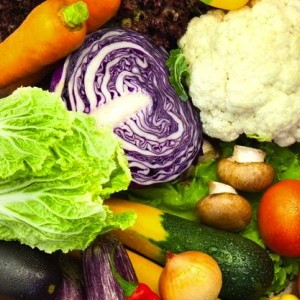You may have heard about the benefits of an alkalizing diet, but maybe you didn’t exactly know what that meant, why it was important, or how to achieve it. Or maybe you just thought acid and alkaline were words from your tenth grade chemistry class. Hopefully this post will take a bit of the mystery out of the effects of acid or alkaline foods on our bodies.
 We all know that eating foods rich in vitamins, minerals, antioxidants, phytonutrients, and fiber is good for our bodies. We also know to look for whole food sources of grains and complex carbohydrates, healthy fats, and quality proteins. And since we are all biochemically different and have different needs at different stages of our life, what kinds or foods and how much will differ from person to person. All of this is really about balance—eating a variety of foods, in a rainbow of colors, to achieve balance in our bodies. Examining the acid-alkaline balance of our foods in just another tool to help us achieve this goal.
We all know that eating foods rich in vitamins, minerals, antioxidants, phytonutrients, and fiber is good for our bodies. We also know to look for whole food sources of grains and complex carbohydrates, healthy fats, and quality proteins. And since we are all biochemically different and have different needs at different stages of our life, what kinds or foods and how much will differ from person to person. All of this is really about balance—eating a variety of foods, in a rainbow of colors, to achieve balance in our bodies. Examining the acid-alkaline balance of our foods in just another tool to help us achieve this goal.
Our body tissues and blood are slightly alkaline. Stressors—in the form of infections, pollution, improper digestion, and a diet high in acidic foods—can all lead to more acid in the body (Haas, 2006). According to The Joy of Food: The Alkaline Way (2008-2009), too much acid in the body is harmful because “the body links these excess acids with alkaline minerals . . . and excretes them. Over time, this can deplete the body of needed minerals and lead to a build-up of excess acids in your cells. This reduces the efficiency and effectiveness of your cells and tissues” (p. 5). In order to counteract and prevent this build-up of acid from occurring in our cells, it is beneficial to include more alkaline foods in our diet.
The body needs the acid-buffering minerals of potassium, calcium and magnesium in order to keep our bodies at a balanced pH (Jaffe and Donovan in The Joy of Food: The Alkaline Way, 2008-2009, p. 15). Our bodies function best in an alkaline environment, and we need these mineral-buffering reserves from an alkaline diet to help us counteract the effects of acid in our bodies: “A diet that is predominantly alkaline forming is essential to the maintenance of sustained health” (p. 15). So what does this mean? What foods are alkaline or acid?
When looking at whether a food is considered alkaline or acidic, we are looking at how the food metabolizes in the body. For example, although lemon juice itself is acidic, it becomes alkalizing once it is metabolized by the body. Cow’s milk, on the other hand, is alkaline itself but becomes acidic in the body. Sound a little confusing? It can be at first but one thing that helps a lot is a chart that lists alkaline and acidic foods. There are many available on the Internet but I like this one created by Dr. Russell Jaffe, one of the leaders in looking at the role of acid in our bodies, on Dr. Liz Lipski’s website.
In general, fresh fruits and vegetables tend to be alkaline. There are a few exceptions like tomatoes, plums, cranberries, figs and carrots. Acidic foods are meats, eggs, beans, and dairy. It is especially important to pay attention to the fact that processed foods full of refined flour and sugar, hydrogenated oils, and salt are all acidic.
Does this mean we need to completely avoid all acidic foods? No, not all of them—eggs, beans, carrots, and tomatoes are all part of a healthy diet, but they need to be in balance with more alkaline foods. The most important step we can take to reduce the acid in our bodies is to avoid processed and refined foods. Elson Haas (2006), a leader in integrated healthcare and nutrition, suggests that a diet that is about 70% alkaline foods will “keep the system functioning optimally, provided we get the balance of vitamins and minerals we need, as well as the essential fatty and amino acids to perform the required fat and protein functions” (p. 394-95). The Joy of Food: The Alkaline Way (2008-2009) recommends that 80% of foods be alkaline for health restoration and 60% alkaline for maintaining health (p. 7).
Here are some easy ways to alkalinize your system:
- Add the juice of lemon, lime or raw apple cider vinegar to 4-6 ounces of water and drink before or with meals
- Add lentils, ginger, yams or sweet potatoes to your diet
- Aim to eat at least two cups of greens a day, like kale, collards, turnip greens, or endive
- Add seaweeds and kelp to your diet. You can eat these as roasted seaweed snacks or add kombu to soups (also helps with digesting beans)
- Drink Kona coffee instead of regular coffee. Kona coffee is still acidic but less so than other coffee beans
- Use ghee instead of butter
What you do NOT need to do is invest any money in alkaline water. For a clear explanation of why you do not need alkaline water, read Dr. Weil’s response here.
What questions do you have about acid/alkaline balance?
References
Haas, E. M. (2006). Staying Healthy with Nutrition. Berkeley, CA: Celestial Arts.
The Joy of Food: The Alkaline Way [Pamphlet]. (2008-2009). RMJ Holdings.

